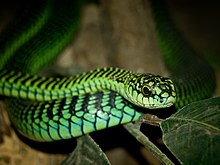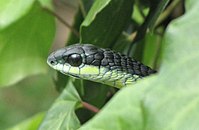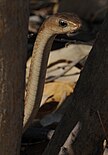| Boomslang | |
|---|---|

| |
| Male at campsite in the Ngorongoro Conservation Area | |
| Conservation status | |
 Least Concern (IUCN 3.1) | |
| Scientific classification | |
| Domain: | Eukaryota |
| Kingdom: | Animalia |
| Phylum: | Chordata |
| Class: | Reptilia |
| Order: | Squamata |
| Suborder: | Serpentes |
| Family: | Colubridae |
| Genus: | Dispholidus |
| Species: | D. typus |
| Binomial name | |
| Dispholidus typus (A. Smith, 1828) | |
| Boomslang distribution Extant (resident) | |
| Synonyms | |
| |
The boomslang (/ˈboʊmslɑːŋ/ or /ˈbɔːmsləŋ/; Dispholidus typus) is a highly venomous snake in the family Colubridae. The species is native to Sub-Saharan Africa.
Etymology
Its common name means "tree snake" in Dutch and Afrikaans – boom meaning "tree", and slang meaning "snake". In Afrikaans, the name is pronounced [ˈbuəmslaŋ].
Taxonomy
The boomslang is a colubrid snake within the subfamily Colubrinae. It belongs to the genus Dispholidus, which contains two other species, D. pembae and D. punctatus.
The boomslang is thought to be closely related to members of the genera Thelotornis, Thrasops, Rhamnophis, and Xyelodontophis, with which it forms the taxonomic tribe Dispholidini.
Close relationships can be shown in the cladogram below:
| |||||||||||||||||||||||||||||||||||||
Subspecies
Two subspecies are recognised, including the nominotypical subspecies.
The trinomial authority in parentheses for D. t. typus indicates that the subspecies was originally described in a genus other than Dispholidus.
Description

The average adult boomslang is 100–160 centimetres (3.3–5.2 ft) in total length (including tail). Some exceed 183 centimetres (6.00 ft). The eyes are exceptionally large, and the head has a characteristic egg-like shape. Colouration is highly variable. Males are light green with black or blue scale edges, but adult females may be brown demonstrating sexual dimorphism.
Weight varies from 175 to 510 g (0.386 to 1.124 lb), with an average weight of 299.4 g (0.660 lb).
In this species, the head is distinct from the neck and the canthus rostralis is distinct. The pupil of the very large eye is round. The boomslang has excellent eyesight and often moves its head from side to side to get a better view of objects directly in front. The maxillary teeth are small anteriorly, seven or eight in number, followed by three very large, grooved fangs situated below each eye. The mandibular teeth are subequal. The body is slightly compressed. The dorsal scales, which are arranged in 19 or 21 rows, are very narrow, oblique, strongly keeled, with apical pits. The tail is long, and the subcaudal scales are paired. Ventral scales are 164–201; the anal plate is divided; and the subcaudals are 91–131.
Geographic range

The boomslang is endemic to Sub-Saharan Africa, from The Gambia, Guinea, Senegal and most of Western Africa (including Benin, Cameroon, Ghana, Nigeria, Togo) through Central and Eastern Africa (Democratic Republic of the Congo, western Ethiopia, Kenya, South Sudan, Tanzania, Uganda). It is found across much of Southern Africa, in a wide array of habitats, with some of the species' densest populations being in Angola, Botswana, Eswatini, Malawi, Mozambique, Namibia, South Africa, Zambia and Zimbabwe.
Habitat
The boomslang is an excellent climber and is highly arboreal, living mainly in forested areas. D. typus lives in karoo shrubs, savannahs, lowland forests, and in grasslands. The boomslang is not restricted to trees and can often be found on the ground hunting, feeding, or taking shelter. It will occasionally hide underground when the weather is harsh.
Reproduction
The boomslang is oviparous, and an adult female can produce up to 30 eggs, which are deposited in a hollow tree trunk or rotting log. The eggs have a relatively long (3 months on average) incubation period. Male hatchlings are grey with blue speckles, and female hatchlings are pale brown. They attain their adult colouration after several years. Hatchlings are about 20 cm (7.9 in) in length and pose no threat to humans, but are dangerously venomous by the time they reach a length around 45 cm (18 in) and a girth as thick as an adult's smallest finger.
Behaviour and diet

D. typus is diurnal and almost exclusively arboreal. It is reclusive, and moves from branch to branch when pursued by anything too large to eat. Its diet includes chameleons and other arboreal lizards, frogs, and occasionally small mammals, birds, and eggs from nesting birds and reptiles, all of which it swallows whole. The boomslang will also feed on other snakes, including cannibalising members of its own species. During cool weather, the boomslang brumates for short periods, often curling up inside the enclosed nest of a weaverbird.
Venom
Many venomous species of the Colubridae are harmless to humans—unless one has a known rare allergy—largely because of small venom glands and inefficient teeth that are situated at the back of the mouth. These species, including the boomslang, are collectively known as "rear-fanged" (or opisthoglyphous) snakes, as their venom-injecting teeth are situated farther back in the mouth than elapids or vipers, and thus require the snake to bite, hold-on, and "chew" the venom into its victim.
However, some opisthoglyphous snakes—including the boomslang—actually possess a highly potent and toxic venom. The boomslang is able to open its jaws up to 170° when biting, facilitating envenomation. The venom of the boomslang is primarily a hemotoxin; it works via a process in which many small clots form in the blood, causing the victim's circulatory system to improperly coagulate, resulting in excessive bleeding and death. The venom has been observed to cause bleeding in tissues such as muscle and the brain (among other organs), while, at the same time, clogging capillaries with tiny blood clots. Other signs and symptoms include headache, nausea, sleepiness, and confusion, leading to cardiac arrest and unconsciousness.
Because boomslang venom is slow-acting, symptoms may not become apparent until many hours after a bite. Although the absence of symptoms provides sufficient time for procuring antivenom, it can also provide victims with false reassurances, leading to underestimation of the seriousness of the bite. Snakes of any species may sometimes fail to inject venom when they bite (a so-called "dry bite" or "bluff strike", enacted in-defense), wherein, after a few hours without any noticeable effects, victims of boomslang bites may falsely believe that their attack was simply a dry or bluff strike. The pathophysiological mechanisms of the venom are different with every snake, resulting in different clinical manifestations with every patient.
An adult boomslang has 1.6 to 8 mg of venom. Its median lethal dose (LD50) in mice is 0.1 mg/kg (intravenously). 0.071 mg/kg (IV) has also been reported. 12.5 mg/kg (subcutaneously) and 1.3–1.8 mg/kg (intraperitoneal). Based on the very low venom quantities produced by D. typus, and the very serious effects found in a good part of the reported cases in humans, it has been suggested that the venom's LD50 is lower in humans than in mice, with only 2 to 3 mg being enough to potentially kill a healthy adult.
In 1957, herpetologist Karl Schmidt died after being bitten by a juvenile boomslang, which he had doubted could produce a fatal dose. He made notes on the symptoms he experienced almost to the end. D. S. Chapman reported eight serious envenomations by boomslangs between 1919 and 1962, two of which were lethal.
Boomslang monovalent antivenom was developed during the 1940s. The South African Vaccine Producers manufactures a monovalent antivenom for use in boomslang envenomations. Treatment of bites may also require complete blood transfusions, especially if over 24-48 hours have passed without antivenom.
The boomslang is a timid snake, and bites generally occur only when people attempt to handle, catch, pursue or kill the animal. When confronted and cornered, it inflates its neck and assumes an S-shaped striking pose, a key indicator of any snake species feeling threatened.
Gallery
-
 A male boomslang
A male boomslang
-
 Boomslang in Western Cape, South Africa
Boomslang in Western Cape, South Africa
-
 Juvenile common boomslang (Dispholidus t. typus)
Juvenile common boomslang (Dispholidus t. typus)
-
 Brown female common boomslang (Dispholidus t. typus)
Brown female common boomslang (Dispholidus t. typus)
References
- ^ Boulenger GA (1896). Catalogue of the Snakes in the British Museum (Natural History). Volume III., Containing the Colubridæ (Opisthoglyphæ and Proteroglyphæ) .... London: Trustees of the British Museum (Natural History). (Taylor and Francis, printers). xiv + 727 pp. + Plates I-XXV. (Genus Dispholidus, pp. 186-187; species Dispholidus typus, pp. 187–189, Figure 14).
- ^ Encyclopædia Britannica. Encyclopædia Britannica, Inc. 2007. ISBN 9781593392925.
- Oxford English Dictionary. Oxford, England: Oxford University Press. 1989.
- Broadley, D.G.; Wallach, V. (2002). "Review of the Dispholidini, with the description of a new genus and species from Tanzania (Serpentes, Colubridae)". Bulletin of the Natural History Museum, Zoology Series. 68 (2). doi:10.1017/S0968047002000079.
- Figueroa, A.; McKelvy, A. D.; Grismer, L. L.; Bell, C. D.; Lailvaux, S. P. (2016). "A species-level phylogeny of extant snakes with description of a new colubrid subfamily and genus". PLOS ONE. 11 (9): e0161070. Bibcode:2016PLoSO..1161070F. doi:10.1371/journal.pone.0161070. PMC 5014348. PMID 27603205.
- Species Dispholidus typus at The Reptile Database . www.reptile-database.org.
- "Boomslang". African Snakebite Institute. 22 October 2017. Retrieved 4 May 2021.
- Grassy E MD (June 22, 1940). "Studies on the Venom of the Boomslang". South African Medical Journal.
- ^ "Observations • iNaturalist". Retrieved 12 May 2024.
- "Boomslang Snake Facts [Ultimate Guide]". 2011-11-19. Archived from the original on 2022-03-31. Retrieved 2022-04-11.
- ^ "ADW: Dispholidus typus: INFORMATION". Animal Diversity Web.
- Marais, Johan (2004). A Complete Guide to the Snakes of Southern Africa. Second Edition. Struik.
- Kamiguti AS, Theakston RD, Sherman N, Fox JW (November 2000). "Mass spectrophotometric evidence for P-III/P-IV metalloproteinases in the venom of the boomslang (Dispholidus typus)". Toxicon. 38 (11): 1613–1620. Bibcode:2000Txcn...38.1613K. doi:10.1016/S0041-0101(00)00089-1. PMID 10775761.
- "LD50 for various snakes". seanthomas.net. Retrieved 2017-11-14.
- Mackessy, Stephen P. (2002). "Biochemistry and Pharmacology of Colubrid Snake Venoms". Journal of Toxicology – Toxin Reviews 21 (1&2): 52. online PDF Archived 2010-06-02 at the Wayback Machine
- Young, R. A. (1996). "IN VITRO ACTIVITY OF DUVERNOY'S GLAND SECRETIONS FROM THE AFRICAN BOOMSLANG, Dispholidus typus, ON NERVE-MUSCLE PREPARATIONS". Journal of Venomous Animals and Toxins. 2 (1): 52–58. doi:10.1590/S0104-79301996000100007.
- Pla, Davinia; Sanz, Libia; Whiteley, Gareth; Wagstaff, Simon C.; Harrison, Robert A.; Casewell, Nicholas R.; Calvete, Juan J. (April 2017). "What killed Karl Patterson Schmidt? Combined venom gland transcriptomic, venomic and antivenomic analysis of the South African green tree snake (the boomslang), Dispholidus typus". Biochimica et Biophysica Acta (BBA) - General Subjects. 1861 (4): 814–823. doi:10.1016/j.bbagen.2017.01.020. ISSN 0006-3002. PMC 5335903. PMID 28130154.
- Mazza, Giuseppe (2011-04-27). "Dispholidus typus". Monaco Nature Encyclopedia. Retrieved 2022-07-09.
- "Diary of A Snakebite Death". YouTube. 27 October 2015.
- "The Boomslang Snake Of Africa". www.reptilesmagazine.com. 21 February 2012. Retrieved 2017-11-14.
- Pope, Clifford H (1958). "Fatal Bite of Captive African Rear-Fanged Snake (Dispholidus)". Copeia. 1958 (4): 280–282. doi:10.2307/1439959. JSTOR 1439959.
- Smith, Charles H. "Chrono-Biographical Sketch: Karl P. Schmidt". Some Biogeographers, Evolutionists and Ecologists. Retrieved 9 September 2014.
- Bücherl W, Buckley E, Deulofeu V (editors) (1968). Venomous Animals and Their Venoms, Volume I: Venomous Vertebrates. Academic Press. p. 484.
- "About Us – South African Vaccine Producers (SAVP)". Archived from the original on 11 April 2021. Retrieved 3 November 2015.
Further reading
- Access Professional Development. 2022. Boomslang (Dispholidus typus). Available: https://accesspd.co.za/species/Boomslang Archived 2022-02-03 at the Wayback Machine (Accessed: 02/02/2022)
- Branch, Bill (2004). Field Guide to Snakes and other Reptiles of Southern Africa. Third Revised edition, Second impression. Sanibel Island, Florida: Ralph Curtis Books. ISBN 0-88359-042-5. (Dispholidus typus, pp. 99–100 + Plate 31).
- Goin CJ, Goin OB, Zug GR (1978). Introduction to Herpetology, Third Edition. San Francisco: W.H. Freeman. ISBN 0-7167-0020-4. (Dispholidus typus, pp. 322, 324.)
- Laurent RF (1955). "Diagnoses preliminaires des quelques Serpents venimeux" (in French). Revue de zoologie et de botanique africaines 51: 127–139. (Dispholidus typus kivuensis, new subspecies; D. t. punctatus, new subspecies.)
- Smith A (1828). "Descriptions of New or Imperfectly Known Objects of the Animal Kingdom, Found in the South of Africa". South African Commercial Advertiser 3 (144): 2. (Bucephalus typus, new species.)
External links
| Taxon identifiers | |
|---|---|
| Dispholidus typus | |